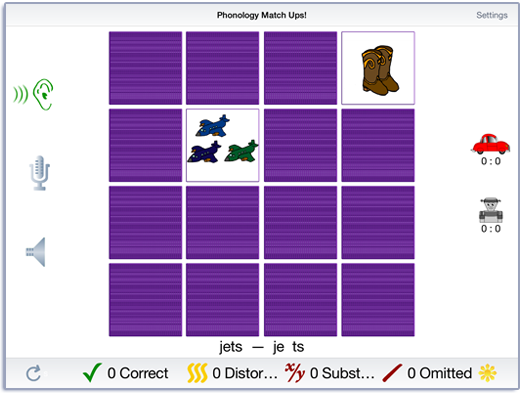
Match Ups! is one of our favorite games of all time. The first version of Match Ups! was added to our Attention and Memory:Volume I CD in 1996 and we’ve been enhancing it ever since. This version uses the words and pictures from our Phonology and Minimal Pairs apps.
The game starts out with you against the computer. At first the computer plays randomly, but you can make the game more challenging by increasing the computer’s skill level to Beginner, Good, or Expert. When playing in the expert level, the computer rarely makes a mistake—it is very hard to beat. You can also play with a friend. Just type their name in the second box and away you go. If you want to play by yourself, you can do that too.
You can play with 4, 6, 16, 24, or 36 cards on the screen. The cards organized into four groups: Final Consonants, Initial Consonants, Initial S Clusters, and Initial L and R clusters. You can choose simple blue, green, purple, or red card backs or spice things up and choose fun backs.
Target Audience Match Ups! is primarily a fun memory game, but this version was made specifically for phonology practice. SLPs tell us that they often use it as a reward at the end of a therapy session.
Just $1.99 on the App Store.
Rationale After being exposed to the sound of the target, the child must have extensive practice in producing the target. Hodson and Paden (1983) emphasize the importance of the client’s saying the target sound or sequence as correctly as possible, so as to reinforce the correct kinesthetic sensations. Our experience has shown that a multi-sensory approach to establishing placement, auditory perception, and kinesthetic feedback on productions has been the most effective approach to improving phonological processing and correct speech production.
This game is appropriate for individuals with auditory/visual short-term memory deficits, as well as verbal rehearsal and confrontation naming problems. This game is also appropriate for children and adults learning English as a second language.
The format is intentionally low key and simple in order to provide an uncomplicated background for learning these concepts. The multisensory approach requires the child to listen to stimuli, repeat information aloud, and touch the screen to make choices.